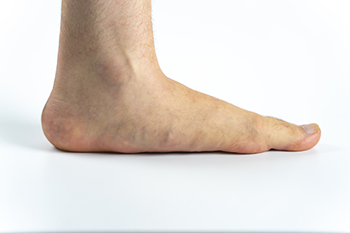It is not unusual for adults to develop flat feet as they age, even though they never had the problem before. Although this condition often affects only one foot, it sometimes occurs in both. Its main cause is changes to the posterior tibial tendon that limit its ability to lift the arch of your foot. Unfortunately, this dysfunction is progressive and usually worsens if not treated. Overuse of the tendon by walking, running, hiking or climbing stairs, is often the main cause. You may start to experience pain, swelling, a flattening of the arch and an inward rolling of your ankle. Eventually, the pain will increase, accompanied by swelling and redness. In the worst cases arthritis may develop. Several non-surgical treatments are available, including braces, orthotics, wearing a cast, and taking medication. In some cases surgery may be required. If you think you may be developing flat feet, it is suggested that you consult a podiatrist at your earliest convenience for a complete examination and to discuss appropriate treatment options.
Flatfoot is a condition many people suffer from. If you have flat feet, contact Dr. Kennedy Legel from Advanced Foot & Ankle Care Specialists. Our doctor will treat your foot and ankle needs.
What Are Flat Feet?
Flatfoot is a condition in which the arch of the foot is depressed and the sole of the foot is almost completely in contact with the ground. About 20-30% of the population generally has flat feet because their arches never formed during growth.
Conditions & Problems:
Having flat feet makes it difficult to run or walk because of the stress placed on the ankles.
Alignment – The general alignment of your legs can be disrupted, because the ankles move inward which can cause major discomfort.
Knees – If you have complications with your knees, flat feet can be a contributor to arthritis in that area.
Symptoms
- Pain around the heel or arch area
- Trouble standing on the tip toe
- Swelling around the inside of the ankle
- Flat look to one or both feet
- Having your shoes feel uneven when worn
Treatment
If you are experiencing pain and stress on the foot you may weaken the posterior tibial tendon, which runs around the inside of the ankle.
If you have any questions please feel free to contact our office located in Dallas, TX . We offer the newest diagnostic and treatment technologies for all your foot and ankle needs.























